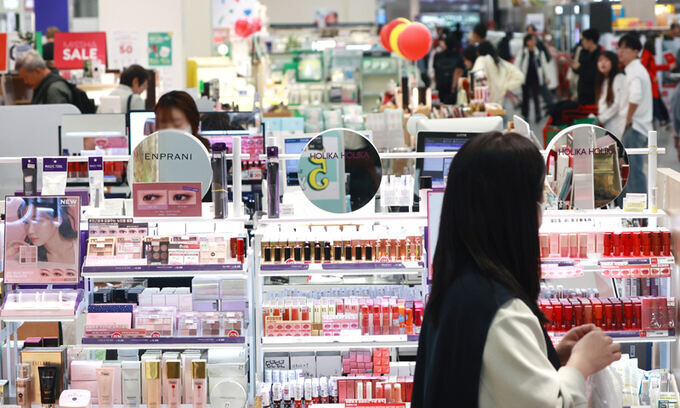
South Korea's K-beauty industry is riding a wave of unprecedented export success, generating significant tailwinds for companies across its intricate supply chain. This robust ecosystem, encompassing raw materials, packaging, manufacturing (ODM), brands, and distribution, is a key strength and unique characteristic of the nation's beauty sector, ensuring that the benefits of increased exports are widely distributed.
Raw Material Suppliers Experience Solid Growth
Leading cosmetic ingredient companies such as Hyundai Bioland, Sunjin Beauty Science, and Daebong LS reported an average revenue growth of 9.9% last year.
Sunjin Beauty Science recorded the most significant growth at 13.3%, achieving ₩56.3 billion in raw material sales. Notably, overseas exports accounted for approximately 80% (₩44.6 billion) of this figure, with inorganic UV filters alone generating ₩22.5 billion in revenue. Hyundai Bioland's cosmetic ingredient sales surpassed the ₩50 billion mark for the first time, reaching ₩53.3 billion.
Packaging Sector Witnesses Explosive Expansion
The packaging and component industry experienced an impressive average revenue growth of 23.4% in the past year.
Pumtech Korea, a prominent domestic cosmetic container manufacturer, reported sales of ₩327.9 billion. The proportion of cosmetic containers in its total revenue increased from 94.7% in 2022 to 97.2% last year. Bukook TNC, an affiliate of Pumtech Korea specializing in tube-type containers, saw its revenue double (99.4%) from ₩35.1 billion in 2022 to ₩70 billion last year. This growth reflects the synergistic business models of Pumtech Korea (focused on pumps and compacts) and Bukook TNC, enabling them to effectively meet rising overall demand. Yeonwoo, a subsidiary of Kolmar Korea, recorded ₩274.8 billion in cosmetic container sales, with exports increasing by 23.4% year-on-year to ₩119.9 billion. Sun & L, initially focused on MDF and plywood, has strategically diversified into cosmetic containers through acquisitions, with this segment now contributing ₩71.6 billion, or 21.1%, to its total revenue.
ODM Powerhouses Enjoy Soaring Sales
Original Design Manufacturing (ODM) companies witnessed an average revenue surge of 42.8% in the preceding year.
Cosmax cemented its leading position with sales exceeding ₩2 trillion (₩2.166 trillion). Following closely were △Kolmar Korea (₩1.3351 trillion) △Cosmecca Korea (₩524.3 billion) △C&C International (₩282.8 billion) △CNF (₩205.8 billion) △Hankook Cosmetics Manufacturing (₩167.4 billion) △Encos (₩152.3 billion). Encos, a specialized mask pack manufacturer, experienced near double revenue growth, fueled by the popularity of its collagen masks. Its Biodance mask pack, manufactured for Beauty Selection, remained within the top 25 beauty brands on Amazon in the first quarter of this year. CNF, initially focused on mask packs, diversified its production lines to include hair care and cleansing foam products in 2021, capitalizing on the K-beauty boom. C&C International, a strong player in color cosmetics ODM, benefited from the popularity of brands like 'Fwee' and 'Clio', favored by domestic and international MZ generations.
Distribution Channels Thrive on Global Reach
Companies connecting K-beauty brands and products to overseas markets also experienced remarkable revenue growth, averaging 80%. Silicon2's revenue doubled in a single year to ₩691.5 billion. Its Corporate Account (CA) division, which supplies various K-beauty products to corporate clients, generated ₩607.4 billion, representing 87.8% of total revenue, with exports alone accounting for ₩565.3 billion. Silicon2's operating profit reached ₩137.5 billion, boasting an impressive operating profit margin of 20%. Asia B&C also reported significant growth, with revenue increasing by 56.7% to ₩116.1 billion and operating profit surging by 134% to ₩10.3 billion year-on-year.
The continued export success of K-beauty underscores the strength and resilience of its domestic supply chain. This interconnected ecosystem, where each sector experiences growth in tandem with the overall industry's expansion, positions South Korea as a dominant force in the global beauty market. The innovation in raw materials, the sophisticated packaging solutions, the reliable manufacturing capabilities of ODM firms, the compelling brand narratives, and the efficient distribution networks all contribute to the sustained international appeal of K-beauty products. As K-beauty continues its global ascent, the specialized companies within its supply chain are poised for further prosperity.
[Copyright (c) Global Economic Times. All Rights Reserved.]



























